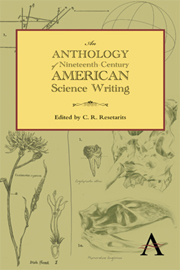Book contents
- Frontmatter
- Contents
- Preface
- Part One 1800–1846 Naturals and Naturalists
- Part Two 1846–1876 Warriors
- Part Three 1876–1900 Scientists
- Part Three Introduction
- “The Fixation of Belief” (excerpt), Popular Science Monthly (1877)
- “How to Make Our Ideas Clear” (excerpt) Popular Science Monthly (1878)
- “Catastrophism and Evolution” (excerpt), The American Naturalist (1877)
- “The Spectrum of an Argand Burner,” Science (1883)
- “The New Astronomy. I. Spots on the Sun” (excerpt), The Century (1885)
- “Screw,” Encyclopedia Britannica, vol. 21, 9th edition (1875–1889)
- “On the Relative Motion of the Earth and the Luminiferous Ether,” American Journal of Science (1887)
- “The Lake as a Microcosm” (excerpt), Bulletin of the Peoria Scientific Association (1887)
- “Laws of Temperature Control of the Geographic Distribution of Terrestrial Animals and Plants,” National Geographic Magazine (1894)
- “The Ecological Relations of the Vegetation on the Sand Dunes of Lake Michigan” (excerpt), Botanical Gazette (1899)
- “On the Equilibrium of Heterogeneous Substances, abstract,” American Journal of Science and Arts (1878)
- Bibliography
“Screw,” Encyclopedia Britannica, vol. 21, 9th edition (1875–1889)
from Part Three - 1876–1900 Scientists
Published online by Cambridge University Press: 05 June 2012
- Frontmatter
- Contents
- Preface
- Part One 1800–1846 Naturals and Naturalists
- Part Two 1846–1876 Warriors
- Part Three 1876–1900 Scientists
- Part Three Introduction
- “The Fixation of Belief” (excerpt), Popular Science Monthly (1877)
- “How to Make Our Ideas Clear” (excerpt) Popular Science Monthly (1878)
- “Catastrophism and Evolution” (excerpt), The American Naturalist (1877)
- “The Spectrum of an Argand Burner,” Science (1883)
- “The New Astronomy. I. Spots on the Sun” (excerpt), The Century (1885)
- “Screw,” Encyclopedia Britannica, vol. 21, 9th edition (1875–1889)
- “On the Relative Motion of the Earth and the Luminiferous Ether,” American Journal of Science (1887)
- “The Lake as a Microcosm” (excerpt), Bulletin of the Peoria Scientific Association (1887)
- “Laws of Temperature Control of the Geographic Distribution of Terrestrial Animals and Plants,” National Geographic Magazine (1894)
- “The Ecological Relations of the Vegetation on the Sand Dunes of Lake Michigan” (excerpt), Botanical Gazette (1899)
- “On the Equilibrium of Heterogeneous Substances, abstract,” American Journal of Science and Arts (1878)
- Bibliography
Summary
The screw is the simplest instrument for converting a uniform motion of rotation into a uniform motion of translation (see “Mechanics,” vol. xv, p. 754). Metal screws requiring no special accuracy are generally cut by taps and dies. A tap is a cylindrical piece of steel having a screw on its exterior with sharp cutting edges; by forcing this with a revolving motion into a hole of the proper size, a screw is cut on its interior forming what is known as a nut or female screw. The die is a nut with sharp cutting edges used to screw upon the outside of round pieces of metal and thus produce male screws. More accurate screws are cut in a lathe by causing the carriage carrying the tool to move uniformly forward, thus a continuous spiral line is cut on the uniformly revolving cylinder fixed between the lathe centres. The cutting tool may be an ordinary form of lathe tool or a revolving saw-like disk (see “Machine Tools,” vol. xv, p. 153).
Errors of Screws. – For scientific purposes the screw must be so regular that it moves forward in its nut exactly the same distance for each given angular rotation around its axis. As the mountings of a screw introduce many errors, the final and exact test of its accuracy can only be made when it is finished and set up for use.
- Type
- Chapter
- Information
- An Anthology of Nineteenth-Century American Science Writing , pp. 237 - 242Publisher: Anthem PressPrint publication year: 2012



